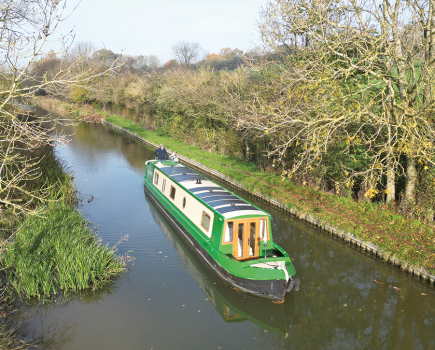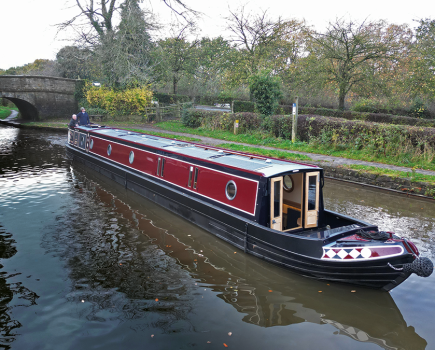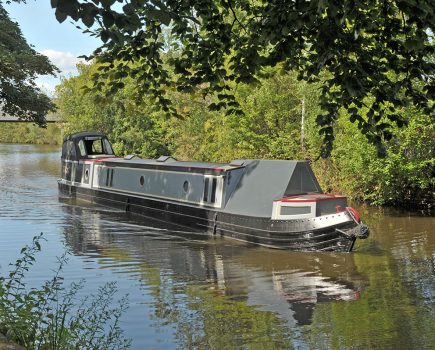Whether or not widebeams are your thing, this ‘planet-saver’ is one of the most technically intriguing boats CB has tested. Adam Porter investigates (pictures by Andy R Annable)

Generally speaking, you’d think boaters would be a pretty eco-friendly bunch. After all, being on a boat – whether as your home or for a holiday – gives you a connection with the outdoors as you’re close to nature, you see plenty of wildlife and you definitely experience everything the weather throws at you. Yet our engines burn diesel, our stoves coal and our loos often use chemicals with dire warnings on the packaging.
So when Nick Clack and Ali Roberts decided to live on a boat, they wanted to build one that was as environmentally sustainable as possible.
There’s sustainable wood in the fit-out, a massive solar array, a composting toilet, electric drive and even under-floor heating, which uses the natural warmth of canal water. Even if a widebeam boat isn’t your thing, this may still be one of the most fascinating boats you’re likely to hear about.
Artie Chalmers of Elton Moss Boat Builders says that not only is it the most complicated build they’ve taken on, it’s probably the most complicated inland waterways boat in the UK.

Exterior
Tulak, built in Elton Moss’s factory in the Czech Republic, is based on their ‘Kingsley’ Dutch barge-style widebeam range. Yet at 12ft wide and 65ft long, it is a bit longer than a standard Kingsley.
The boat is well made, with nice smooth cabin sides and the steelwork is substantial, including a 12mm baseplate. The bow is high and manages to look surprisingly delicate, while the stern is square to maximise space. Unlike most Kingsleys, Tulak has an extra cabin behind the wheelhouse and, for the first time, the roof of this stern cabin has been made into an outside seating area.
It’s slightly flatter than normal (extra bracing was required) and is surrounded by a stainless steel safety rail, which can be unbolted and removed if necessary. Steps leading up to the deck are incorporated into the steelwork. And in another change from the standard boat, Tulak has a full well deck at the bow.
This has lockers either side and access to the bow thruster. An anchor big enough to mean business is hung on the bow, with the chain and winch housed in another locker.
The green and red colour scheme makes a real statement. Nick says they wanted a green that looked brighter than normal and they’ve certainly achieved that. The red roof has a non-slip finish and much of it is covered in solar panels, but space has been left towards the bow so the couple can grow plants.

Layout and fit-out
Nick and Ali were determined to have three bedrooms because they have a three-year-old son, Kaspar, and wanted a guest room. The spare room, behind the wheelhouse, also serves as a snug and an office. The wheelhouse provides the main entry point and has the engine room underneath. Steps then take you down into the main part of the accommodation.
First comes the galley, which has a breakfast bar and is open-plan to the saloon. Some space here has been sacrificed for the third bedroom (Artie Chalmers says the saloon could have been twice the size). From here, a corridor leads down one side of the boat to the other rooms – bathroom, Kaspar’s bedroom then the main cabin at the bow.
The fit-out uses a combination of painted panels above the gunwales and oak below. All the trim and furniture is oak, with the timber coming from sources certified by the Forest Stewardship Council as being responsibly produced. The floor is solid oak and the quality of joinery throughout looks excellent.

Galley
The U-shaped galley provides plenty of worktop space. The tops are made from a brown engineered stone with bright flecks to catch the eye, and which is less likely to crack or be damaged than natural granite.
Set into one side there’s a double Belfast sink and a splash of colour is added by red tiles with the odd patterned one. There are high level cupboards with lights underneath.

Equipment includes a 240-volt fridge and separate freezer, a four-burner Bosch gas hob with an oven underneath and, on the other side, a sideboard offers more storage. None of the cupboards have handles, but instead there are finger holes in the doors, which have the advantage that you can’t catch yourself or your clothes on them.

Saloon
The galley worktop forms a breakfast bar with a couple of stools, dividing it from the saloon. The main feature is a large dresser that offers a range of shelves and cupboards, and houses the TV.
While the saloon might be a little small by widebeam standards, it’s pretty big when you’re used to narrowboats. There’s room for a sofa and another chair. In one corner, there’s a Morso Squirrel stove.

Bathroom
Usefully, the door slides as a space-saving measure. As this is a widebeam, there’s plenty of room for a bath – pretty much essential when you have a three-year-old – with a shower over.
There’s a unit with a smart white basin and a full height cupboard with storage at the top and a washer/dryer at the bottom. In line with their eco credentials, Nick and Ali have chosen an AEG machine that uses heat pump technology to re-circulate hot air. It’s claimed to be 40 percent more efficient than a standard A-rated machine.

The most eco-friendly item in the bathroom is the composting toilet. The Airhead separates liquids from solids and has a fan that draws air across the solids container to dry them out. This boat has space for extra containers, so the solids can be kept for several months to compost fully.
Three bedrooms
Kaspar’s room is based on Elton Moss’s standard bunk room, but with a few additions, such as the box storage unit that forms steps up to the top bunk. The bunks themselves have storage underneath, and there’s a sizeable wardrobe.

Up front, the main cabin in the bow features a large bed, two double wardrobes and a unit of cupboards and shelves. The bed houses the water tank, which holds around 950 litres and there’s a fold-up rack for drying clothes.
Usually in a Dutch barge-style boat there would be just a small set of doors as an escape hatch, leading onto a high-level front deck, but this boat has a full well deck, so the doors are full-height, too.

The third cabin at the stern has a unit with cupboards and shelves on one wall, while the L-shaped seating (raised to take account of the boat’s swims) is a versatile piece of furniture. A folding table means it can be used as an office or dining space, and it converts into a guest bed. There’s also a set of doors to the stern.

Wheelhouse
It was essential in a boat of this layout that the wheelhouse felt as if it was part of the interior, not just an outside space with a cover, and it does. The space is dominated by the steering position, with a wheel and an impressive range of instruments, but it also includes a fixed bench seat with storage underneath.

The wheelhouse framework is made of a hardwood, iroko, and is collapsible. An automatic electric version is available, but Nick and Ali went for the manual option, which Nick admits does take some time to dismantle. The roof comes off in five sections and all the windows fold down. The family has only had to do this once so far, to get under an arched bridge on the Kennet & Avon.
Technical
As you might expect, this is where Tulak gets complicated. Normally, we’d start with the engine, but this boat doesn’t have one – not a normal diesel engine, anyway. It has an electric drive system, using a 48-volt 20kW Fischer Panda electric motor. It was Artie Chalmers who suggested this system, reasoning that Nick and Ali were already equipping the boat with a big battery bank, lots of solar panels and a back-up generator, so why not make full use of that system and avoid the need for another diesel unit?
So the battery bank is large. There are eight Rolls batteries, each of 468Ah, but as such a massive bank needs a lot of charging, the solar array is the sort of size you might normally find on a house – ten 240W panels – and there’s a Fischer Panda diesel generator of 13kW.
The generator is programmed to kick in automatically when needed, so it will come on when the batteries drop to a certain state of charge or when the draw on them reaches a certain level. In practice, this means that turning on an electric kettle will mean the generator starts up, and it’s on while underway.

The electrical system is fiendishly complicated. There’s a 12-volt circuit for things such as the LED lights, the bow thruster (a Vetus 95kgf model) is 24 volts, the propulsion motor is 48 volts, and there’s the 240-volt circuit for the fridge and so on, run by a 5kW Victron inverter.
But if you thought the drive and electrical systems were interesting, the heating is little short of revolutionary. There’s no boiler in a conventional sense, but a heat pump uses the natural warmth of the canal or river water to provide both heating and hot water.
In land-based systems, these heat pumps use the warmth stored in the earth, collected via an extensive system of pipes buried a metre underground. The equivalent on this boat is a massive skin tank on the baseplate, underneath the engine room. The liquid from this skin tank passes into the heat pump, where it goes through the first of two heat exchangers.
The other side of the heat exchanger contains a liquid with a very low boiling point, so the warmth from the canal water, even at just a few degrees, turns it into gas. This gas passes through a compressor, heating it up. The hot gas goes through the second heat exchanger, where it warms the heating and hot water system. As the gas cools it condenses back into a liquid, ready to go around again.
There are several electrical parts in the system, a pump for the skin tank liquid and compressor and another pump for the heating system. But the makers of the pump, Kensa, say that for every unit of electricity used, between three and four units of heat are created. The heat pump itself is relatively small – Kensa don’t call it their Shoe Box pump for nothing.
There’s a large hot water tank in the engine room, while heating comes from an under-floor network of pipes, zoned by room. The pipes (and, therefore, the floor) won’t get hot. The idea is to have a constant low level background heat. If it’s not quite enough, this boat has the saloon stove as a back-up. In addition, the insulation is far thicker, particularly on the roof, than you’d find in a normal boat.

Nick says the system has worked well, providing plentiful hot water. The real test will come in the depths of winter, but remember that even in freezing conditions, canals in this country freeze only to a depth of a few inches, and the water underneath the ice continues to remain at a fairly constant temperature.
On the water
This is a big boat, and if anything it looks even bigger when behind the wheel. The roof stretches out in front of you and there’s still quite a lot of boat behind you, too.
Although wheel steering takes a bit of getting used to after a tiller, this boat has the advantage of a gauge to indicate the angle of the rudder. It’s an hydraulic system so it’s not as immediate as a traditional tiller, meaning there’s a slight delay before the effects of turning the wheel start to happen.
The electric motor is amazingly quiet and surprisingly powerful. Reversing off the mooring happened in complete silence. Even when the generator kicks in, it’s hardly noticeable.

The other surprising thing, given its size, is how well the boat handles. Once it starts to turn, it responds really well – you could certainly spin it in its own length. What’s more, the bow thruster has plenty of grunt, too.
Conclusion
Tulak is a fascinating boat. A lot of rooms have been fitted into the space, the layout works well and the quality of the fit-out is excellent. But where it really delivers is the technical side. Dispensing with a diesel and having an electric motor, a big battery bank, solar panels and a generator seems very sensible.
It’s environmentally friendly, creating heat out of almost nothing and with a tried-and-tested composting toilet. The heating system is perhaps more of a gamble, but there’s no reason why it shouldn’t work.
Of course, the cost of all this adds up. So while a standard Kingsley widebeam would have been around £150,000 (excluding VAT), the highly bespoke Tulak came in at £200,000. It’s worth noting, though, that a boat this size easily qualifies for zero VAT if it’s a residential one.

Nick and Ali set out to build the most sustainable boat they could. What they’ve achieved is remarkable, and credit must go to Elton Moss for taking up the idea and running with it. It might be a complicated boat, but it’s a very thought-provoking one.
___________________
More Boat Tests:
Elsie Alice by Soar Valley Steel Boats
Image(s) provided by:
Archant







